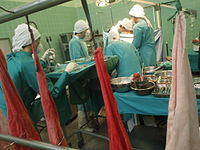
Photo from wikipedia
INTRODUCTION Solid organ transplantation is an established therapy for end-stage organ failure. Both pre-transplantation bone disease and immunosuppressive regimens result in rapid bone loss and increased fracture rates. METHODS The… Click to show full abstract
INTRODUCTION Solid organ transplantation is an established therapy for end-stage organ failure. Both pre-transplantation bone disease and immunosuppressive regimens result in rapid bone loss and increased fracture rates. METHODS The European Calcified Tissue Society (ECTS) formed a working group to perform a systematic review of existing literature on the consequences of end-stage kidney, liver, heart, and lung disease on bone health. Moreover, we assessed the characteristics of post-transplant bone disease and the skeletal effects of immunosuppressive agents and aimed to provide recommendations for the prevention and treatment of transplantation-related osteoporosis. RESULTS Characteristics of bone disease may differ depending on the organ that fails, but patients awaiting solid organ transplantation frequently depict a wide spectrum of bone and mineral abnormalities. Common features are a decreased bone mass and impaired bone strength with consequent high fracture risk, all of which are aggravated in the early post-transplantation period. CONCLUSION Both the underlying disease leading to end-stage organ failure and the immunosuppression regimens implemented after successful organ transplantation have detrimental effects on bone mass, quality and strength. Given existing ample data confirming the high frequency of bone disease in patients awaiting solid organ transplantation, we recommend that all transplant candidates should be assessed for osteoporosis and fracture risk and, if indicated, treated before and after transplantation. Since bone loss in the early post-transplantation period occurs in virtually all solid organ recipients and is associated with glucocorticoid administration, the goal should be to use the lowest possible dose and to taper and withdraw glucocorticoids as early as possible.
Journal Title: Bone
Year Published: 2019
Link to full text (if available)
Share on Social Media: Sign Up to like & get
recommendations!